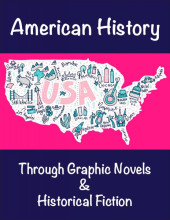Autumn Wetli-Staneluis
Library Blogs
Showing 721 - 730 of 1968 items

The July display of Undergraduate Library books in the Shapiro Lobby explores American history through a collection of graphic novels and historical fiction.

For the first week of the month after Pride month(aka July) I am posting video media about LGBTQIA+ folks. I've tried to include a little bit of everything from streaming sites, feature films, indie films, and documentaries. I hope you've enjoyed this Pride Recommendation series!

The Spring semester has kicked off and orientation season is in full swing, so we thought it would be a good time to showcase our collection of games here at the CVGA. Here are a few visualizations for our collection of more than 8,000 video games, board games, game soundtracks, and more.

In honor of Pride Month I decided to do a series of fiction and film recommendation list to the blog. This week I've created a list of science fiction/fantasy, romance, and poetry/short story anthologies. Two weeks ago I did adult fiction, young adult fiction, and graphic novels. Next week will be the final post about video media.

This week and next we are featuring images from a Kamada Collection text related to warriors.

U-M Library Search launched in late July 2018, combining Mirlyn, ArticlesPlus, and Search Tools into a single discovery interface. Over the past academic year, much work has gone into providing functionality available in the previous interfaces, resolving bugs, and improving the overall user experience.

The Special Collection Research Center recently acquired an early Japanese astronomy book titled 天経或問 (Japanese: Tenkei wakumon; Chinese: Tianjing huowen:"Questions and Answers on Astronomy"). Printed in 1730 in Tōkyō, it was a republication of a Chinese astronomy work supplemented with Japanese reading marks. Chinese Studies Librarian Liangyu Fu introduces us to this new acquisition.
•
Craig Smith, the Library's Assessment Specialist, talks about working with the Design Lab to design and print a replacement battery cover for his vintage Sony Walkman cassette player.

Emily, a young woman from an upper-class British family during World War I, falls in love with Robbie, an Australian pilot, to her parents' disapproval. When he's sent back to the war, she enlists as a land girl, working on farms while the men are away at war. She is assigned to take care of the garden at the estate of a reclusive old woman, and there she discovers a mystery related to the previous inhabitant of the cottage where she lives.

In our last post, we discussed Asia Library’s purchase of more than 20,000 volumes from the Kamada Library in Sakaide, Kagawa Prefecture, and highlighted a couple of items from the collection. This time we are featuring two more texts related to the traditional performing arts.